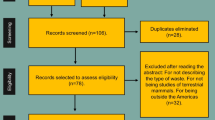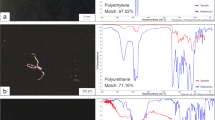Abstract
Pollution by anthropogenic litter is a major threat to global ecosystems. Seabirds are frequently used as environmental monitors of litter ingestion, but similar research is rare for terrestrial birds. Here, we focused on pellet analysis from 117 nests of an iconic bird of the Western Palearctic, the white stork (Ciconia ciconia), breeding in southern and southwestern Poland in a farmland landscape, far away from large dumps and landfills. We found that most prey items in the diet of white storks were invertebrates (particularly from orders Coleoptera, Orthoptera, and Hymenoptera) but vertebrate prey comprised most of the biomass. Further analysis revealed that anthropogenic litter was found in 22.7% of pellets (34.2% of breeding pairs) with plastic (8.4%) and cigarette filters (6.9%) being most prevalent. This study represents the first assessment through pellet analysis of the ingestion of anthropogenic litter by live wild storks in Poland and also by a migratory population of white storks. Our study indicates a potentially significant transfer of plastic and other anthropogenic material through terrestrial food webs.


Similar content being viewed by others
Data availability
The data that support the findings of this study are available in the Supplementary material.
References
Acampora H, Berrow S, Newton S, O’Connor I (2017) Presence of plastic litter in pellets from Great Cormorant (Phalacrocorax carbo) in Ireland. Mar Pollut Bull 117(1–2):512–514. https://doi.org/10.1016/J.MARPOLBUL.2017.02.015
Azzarello MY, van Vleet ES (1987) Marine birds and plastic pollution. Mar Ecol - Prog Se 37(2/3):295–303. https://doi.org/10.3354/meps037295
Baker LA, Warren R, James E (1993) Bobcat prey digestibility and representation in scats. J Southeastern Assoc Fish Wildlife Agencies 47:71–79
Barrett RT, Camphuysen K, Anker-Nilssen T, Chardine JW, Furness RW, Garthe S et al (2007) Diet studies of seabirds: a review and recommendations. ICES J Mar Sci 64(9):1675–1691. https://doi.org/10.1093/ICESJMS/FSM152
Bergmann M, Gutow L, Klages M (2015) Marine anthropogenic litter. SpringerOpen, Cham
Bond AL, Hutton I, Lavers JL (2021) Plastics in regurgitated flesh-footed shearwater (Ardenna carneipes) boluses as a monitoring tool. Mar Pollut Bull 168:112428. https://doi.org/10.1016/J.MARPOLBUL.2021.112428
Bouland AJ, White AE, Lonabaugh KP, Varian-Ramos CW, Cristol DA, Bouland AJ et al (2012) Female-biased offspring sex ratios in birds at a mercury-contaminated river. J Avian Biol 43(3):244–251. https://doi.org/10.1111/J.1600-048X.2012.05612.X
Bourne WRP, Imber MJ (1982) Plastic pellets collected by a prion on Gough Island, central south Atlantic Ocean. Mar Pollut Bull 13:20–21
Ciach M, Kruszyk R (2010) Foraging of white storks Ciconia ciconia on rubbish dumps on non-breeding grounds. Waterbirds 33(1):101–104. https://doi.org/10.1675/063.033.0112
Codina-García M, Militão T, Moreno J, González-Solís J (2013) Plastic debris in Mediterranean seabirds. Mar Pollut Bull 77(1–2):220–226. https://doi.org/10.1016/J.MARPOLBUL.2013.10.002
Danner GR, Chacko J, Brautigam F (2011) Voluntary ingestion of soft plastic fishing lures affects brook trout growth in the laboratory. North Am J Fish Manag 29(2):352–360. https://doi.org/10.1577/M08-085.1
de Souza Machado AA, Kloas W, Zarfl C, Hempel S, Rillig MC (2018) Microplastics as an emerging threat to terrestrial ecosystems. Glob Change Biol 24(4):1405–1416. https://doi.org/10.1111/GCB.14020
Denac D (2006) Intraspecific exploitation competition as cause for density dependent breeding success in the white stork. Waterbirds 29(3):391–394. https://doi.org/10.1675/1524-4695(2006)29
Deudero S, Alomar C (2015) Mediterranean marine biodiversity under threat: reviewing influence of marine litter on species. Mar Pollut Bull 98(1–2):58–68. https://doi.org/10.1016/J.MARPOLBUL.2015.07.012
Duis K, Coors A (2016) Microplastics in the aquatic and terrestrial environment: sources (with a specific focus on personal care products), fate and effects. Environ Sci Eur 28(2):1–25. https://doi.org/10.1186/S12302-015-0069-Y
Elliott A, Garcia EFJ, Boesman PFD (2020) White stork (Ciconia ciconia), version 1.0. In: del Hoyo J, Elliott A, Sargatal J, Christie DA, de Juana E (Eds.), Birds of the world. Ithaca, NY: Cornell Lab of Ornithology. https://doi.org/10.2173/bow.whisto1.01
Furness RW (1985a) Ingestion of plastic particles by seabirds at Gough Island, South Atlantic Ocean. Environ Pollut Ser A, Ecol Biol 38(3):261–272. https://doi.org/10.1016/0143-1471(85)90131-X
Furness RW (1985b) Plastic particle pollution: accumulation by procellariiform seabirds at Scottish colonies. Mar Pollut Bull 16(3):103–106. https://doi.org/10.1016/0025-326X(85)90531-4
Henry P-Y, Wey G, Balança G (2011) Rubber band ingestion by a rubbish dump dweller, the white stork (Ciconia ciconia). Waterbirds 34(4):504–508
Holland ER, Mallory ML, Shutler D (2016) Plastics and other anthropogenic debris in freshwater birds from Canada. Sci Total Environ 571:251–258. https://doi.org/10.1016/J.SCITOTENV.2016.07.158
Horton AA, Walton A, Spurgeon DJ, Lahive E, Svendsen C (2017) Microplastics in freshwater and terrestrial environments: evaluating the current understanding to identify the knowledge gaps and future research priorities. Sci Total Environ 586:127–141. https://doi.org/10.1016/J.SCITOTENV.2017.01.190
Johst K, Brandl R, Pfeifer R (2001) Foraging in a patchy and dynamic landscape: human land use and the white stork. Ecol Appl 11(1):60–69. https://doi.org/10.1890/1051-0761(2001)011[0060:FIAPAD]2.0.CO;2
Karg J (1989) Differentiation in the density and biomass of flying insects in the agricultural landscape of the western Wielkopolska. Roczniki Akademii Rolniczej w Poznaniu Rozprawy Naukowe 188:1–78
Kaza S, Yao LC, Bhada-Tata P, van Woerden F (2018) What a waste 2.0: a global snapshot of solid waste management to 2050. What a waste 2.0: a global snapshot of solid waste management to 2050. Washington, DC: World Bank. https://doi.org/10.1596/978-1-4648-1329-0
Kühn S, Bravo Rebolledo EL, Franeker JA (2015) Deleterious effects of litter on marine life. In: Bergmann M, Gutow L, Klages M (eds) Marine anthropogenic litter. Cham, SpringerOpen, pp 75–116
Lavers JL, Bond AL, Hutton I (2014) Plastic ingestion by flesh-footed shearwaters (Puffinus carneipes): implications for fledgling body condition and the accumulation of plastic-derived chemicals. Environ Pollut 187:124–129. https://doi.org/10.1016/J.ENVPOL.2013.12.020
MacLeod M, Arp HPH, Tekman MB, Jahnke A (2021) The global threat from plastic pollution. Science 373(6550):61–65. https://doi.org/10.1126/science.abg5433
Mallory ML, Robinson SA, Hebert CE, Forbes MR (2010) Seabirds as indicators of aquatic ecosystem conditions: a case for gathering multiple proxies of seabird health. Mar Pollut Bull 60(1):7–12. https://doi.org/10.1016/J.MARPOLBUL.2009.08.024
Massemin-Challet S, Gendner JP, Samtmann S, Pichegru L, Wulgué A, le Maho Y (2006) The effect of migration strategy and food availability on White Stork Ciconia ciconia breeding success. Ibis 148(3):503–508. https://doi.org/10.1111/J.1474-919X.2006.00550.X
Milchev B, Chobanov D, Simov N (2013) Diet and foraging habitats of non-breeding white storks (Ciconia ciconia) in Bulgaria. Arch Biol Sci 65(3):1007–1014. https://doi.org/10.2298/ABS1303007M
Nowakowski JJ (2003) Habitat structure and breeding parameters of the White Stork Ciconia ciconia in the Kolno Upland (NE Poland). Acta Ornithologica 38(1):39–46. https://doi.org/10.3161/068.038.0109
Orłowski G, Karg J, Czarnecka J, Jerzak L, Zub K, Bochenski M (2014) The diet and prey composition and endozoochorous seed dispersal in white storks Ciconia ciconia in western Poland: preliminary findings and further research questions and needs. In: Proceedings of the 1st International White Stork Conference, Zielona Góra, Poland, pp. 40–41
Orłowski G, Karg J (2011) Diet of nestling barn swallows Hirundo rustica in rural areas of Poland. Cent Eur J Biol 6(6):1023–1035. https://doi.org/10.2478/S11535-011-0070-4
Orłowski G, Karg J (2013) Diet breadth and overlap in three sympatric aerial insectivorous birds at the same location. Bird Study 60(4):475–483. https://doi.org/10.1080/00063657.2013.839622
Peris SJ (2003) Feeding in urban refuse dumps: ingestion of plastic objects by the white stork (Ciconia ciconia). Ardeola 50(1):81–84
Pettit TN, Grant GS, Whittow GC (1981) Ingestion of plastics by Laysan albatross. Auk 98(4):839–841
Pierce KE, Harris RJ, Larned LS, Pokras MA (2004) Obstruction and starvation associated with plastic ingestion in a Northern Gannet Morus bassanus and a Greater Shearwater Puffinus gravis. Mar Ornithol 32:187–189
Rabaça JE, Ventura T, Faria N, Roque I (2021) Foraging in landfills: feeding behavior of the white stork (Ciconia ciconia) and kleptoparasitism by black kites (Milvus migrans). Wilson J Ornithol 132(3):513–521. https://doi.org/10.1676/19-10
Resano-Mayor J, Hernández-Matías A, Real J, Parés F, Inger R, Bearhop S (2014) Comparing pellet and stable isotope analyses of nestling Bonelli’s Eagle Aquila fasciata diet. Ibis 156(1):176–188. https://doi.org/10.1111/IBI.12095
Roman L, Hardesty BD, Hindell MA, Wilcox C (2019) A quantitative analysis linking seabird mortality and marine debris ingestion. Sci Rep 9(1):1–7. https://doi.org/10.1038/s41598-018-36585-9
Rosin ZM, Kwiecinski Z (2011) Digestibility of prey by the white stork (Ciconia ciconia) under experimental conditions. Ornis Fennica 88(2):40–51
Ryan PG (1987a) The incidence and characteristics of plastic particles ingested by seabirds. Mar Environ Res 23(3):175–206. https://doi.org/10.1016/0141-1136(87)90028-6
Ryan PG (1987b) The effects of ingested plastic on seabirds: correlations between plastic load and body condition. Environ Pollut 46(2):119–125. https://doi.org/10.1016/0269-7491(87)90197-7
Ryan PG (1988) Effects of ingested plastic on seabird feeding: evidence from chickens. Mar Pollut Bull 19(3):125–128. https://doi.org/10.1016/0025-326X(88)90708-4
Sherlock C, Fernie KJ, Munno K, Provencher J, Rochman C (2022) The potential of aerial insectivores for monitoring microplastics in terrestrial environments. Sci Total Environ 807:150453. https://doi.org/10.1016/J.SCITOTENV.2021.150453
Shoffner AV, Brittingham M (2013) Freeze-drying to preserve birds for teaching collections. Northeastern Nat 20(3):441–450. https://doi.org/10.1656/045.020.0309
Speakman JR (1991) The impact of predation by birds on bat populations in the British Isles. Mammal Rev 21(3):123–142. https://doi.org/10.1111/J.1365-2907.1991.TB00114.X
Spear LB, Ainley DG, Ribic CA (1995) Incidence of plastic in seabirds from the tropical pacific, 1984–1991: relation with distribution of species, sex, age, season, year and body weight. Mar Environ Res 40(2):123–146. https://doi.org/10.1016/0141-1136(94)00140-K
Tanaka K, Takada H, Yamashita R, Mizukawa K, Fukuwaka M-A, Watanuki Y (2013) Accumulation of plastic-derived chemicals in tissues of seabirds ingesting marine plastics. Mar Pollut Bull 69(1–2):219–222. https://doi.org/10.1016/J.MARPOLBUL.2012.12.010
Tortosa FS, Caballero JM, Reyes-López J (2002) Effect of rubbish dumps on breeding success in the white stork in southern Spain. Waterbirds 25:39–43. https://doi.org/10.1675/1524-4695(2002)025[0039:eordob]2.0.co;2
Tryjanowski P, Kuzniak S (2002) Population size and productivity of the white stork Ciconia ciconia in relation to Common Vole Microtus arvalis density. Ardea 90:213–217
Tryjanowski P, Sparks TH, Jakubiec Z, Jerzak L, Kosicki JZ, Kuźniak S et al (2005) The relationship between population means and variances of reproductive success differs between local populations of white stork (Ciconia ciconia). Popul Ecol 47(2):119–125. https://doi.org/10.1007/S10144-005-0217-0
van Franeker JA, Law KL (2015) Seabirds, gyres and global trends in plastic pollution. Environ Pollut 203:89–96. https://doi.org/10.1016/J.ENVPOL.2015.02.034
van Franeker JA, Blaize C, Danielsen J, Fairclough K, Gollan J, Guse N et al (2011) Monitoring plastic ingestion by the northern fulmar Fulmarus glacialis in the North Sea. Environ Pollut 159(10):2609–2615. https://doi.org/10.1016/J.ENVPOL.2011.06.008
Vitt LJ (1978) Caloric content of lizard and snake (Reptilia) eggs and bodies and the conversion of weight to caloric data. J Herpetol 12(1):65. https://doi.org/10.2307/1563505
Wilcox C, van Sebille E, Hardesty BD, Estes JA (2015) Threat of plastic pollution to seabirds is global, pervasive, and increasing. Proc Natl Acad Sci USA 112(38):11899–11904. https://doi.org/10.1073/PNAS.1502108112
Wuczyński A, Krogulec G, Jakubiec Z, Profus P, Neubauer G (2021) Population size and spatial distribution of the white stork Ciconia ciconia in Poland in 1958 with insights into long-term trends in regional and global population. Eur Zool J 88(1):525–539. https://doi.org/10.1080/24750263.2021.1898685
Zhao S, Zhu L, Li D (2016) Microscopic anthropogenic litter in terrestrial birds from Shanghai, China: not only plastics but also natural fibers. Sci Total Environ 550:1110–1115. https://doi.org/10.1016/J.SCITOTENV.2016.01.112
Ziccardi LM, Edgington A, Hentz K, Kulacki KJ, Kane Driscoll S (2016) Microplastics as vectors for bioaccumulation of hydrophobic organic chemicals in the marine environment: a state-of-the-science review. Environ Toxicol Chem 35(7):1667–1676. https://doi.org/10.1002/ETC.3461
Acknowledgements
We are thankful to farmers and volunteers who helped us during the recording of white stork nests. We would also like to thank Tim Sparks for English language correction and Zbigniew Kwieciński for help with pellet data interpretation.
Author information
Authors and Affiliations
Contributions
LJ, KW, and PT established the original idea of the study in the field; PM with help from PT did analyses; PM wrote the first version of the manuscript with the help from PT; JK identified the prey from pellets; LJ, KW, JS, SC, KM, MP, HS, and JW collected pellets in the field. All authors accepted the final version of the manuscript.
Corresponding author
Ethics declarations
Ethical approval and consent to participate
Not applicable.
Consent for publication
All authors have consent for publication.
Competing interests
The authors declare no competing interests.
Additional information
Responsible Editor: Philippe Garrigues
Publisher's Note
Springer Nature remains neutral with regard to jurisdictional claims in published maps and institutional affiliations.
Supplementary Information
Below is the link to the electronic supplementary material.
Rights and permissions
Springer Nature or its licensor (e.g. a society or other partner) holds exclusive rights to this article under a publishing agreement with the author(s) or other rightsholder(s); author self-archiving of the accepted manuscript version of this article is solely governed by the terms of such publishing agreement and applicable law.
About this article
Cite this article
Mikula, P., Karg, J., Jerzak, L. et al. Diet analysis and the assessment of plastic and other indigestible anthropogenic litter in the white stork pellets. Environ Sci Pollut Res 31, 6922–6928 (2024). https://doi.org/10.1007/s11356-023-31710-2
Received:
Accepted:
Published:
Issue Date:
DOI: https://doi.org/10.1007/s11356-023-31710-2




